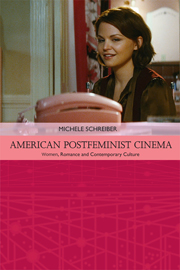Book contents
- Frontmatter
- Contents
- Acknowledgments
- List of Illustrations
- Introduction: Women, Postfeminism and Romance
- 1 ‘Both Glad and Sorry’: Romance Cycles and Women's Politics
- 2 Pragmatism vs. Sentimentality: Amelioration in the Postfeminist Cycle
- 3 Past vs. Present: Temporality in the Postfeminist Cycle
- 4 Sexy vs. Funny: Sexuality in the Postfeminist Cycle
- 5 Independence vs. Dependence: Economics in the Postfeminist Cycle
- Conclusion: Beginnings vs. Endings: the Future of the Postfeminist Cycle
- Selected Bibliography
- Index
4 - Sexy vs. Funny: Sexuality in the Postfeminist Cycle
Published online by Cambridge University Press: 05 September 2014
- Frontmatter
- Contents
- Acknowledgments
- List of Illustrations
- Introduction: Women, Postfeminism and Romance
- 1 ‘Both Glad and Sorry’: Romance Cycles and Women's Politics
- 2 Pragmatism vs. Sentimentality: Amelioration in the Postfeminist Cycle
- 3 Past vs. Present: Temporality in the Postfeminist Cycle
- 4 Sexy vs. Funny: Sexuality in the Postfeminist Cycle
- 5 Independence vs. Dependence: Economics in the Postfeminist Cycle
- Conclusion: Beginnings vs. Endings: the Future of the Postfeminist Cycle
- Selected Bibliography
- Index
Summary
If you spell sex in marketing materials, it doesn't sell. If you spell fun, it sells. Sex inside a comedy candy-coats sex and allows the audience to feel comfortable. Laughter covers up insecurity. Sex sells, but not serious sex. Films can be sexy, but they can't portray the sexual intimacy most people crave. In the movies, you have to make safe sex palatable to a younger audience. The portrayal has to be violent or funny.
Producer Peter Guber, The Hollywood ReporterFor those who presume that Hollywood's ideological inner workings operate at an unconscious level, Peter Guber's comments regarding sexuality in the above quote, while disturbing, are refreshingly transparent. Sexuality, he contends, has a particular place in contemporary Hollywood films. It must be presented in one of two styles, either comedic or violent, in order to put the audience at ease. However, sex portrayed in a ‘realistic’ manner cannot be represented in mainstream films because it does not sell, particularly, as Guber goes on to say, to a very important segment of the population – men. This chapter reflects on the implications of Guber's sentiments by examining the discourses in and around female sexuality in the postfeminist romance cycle. In the post-Code era, sexuality is both highly visible and increasingly invisible, depending on the media form that one is considering. On one end of the cultural spectrum we have what Ariel Levy has identified as ‘raunch’ culture, wherein women and young girls' sexual identity revolves around being seen as a sexual object.
- Type
- Chapter
- Information
- American Postfeminist CinemaWomen, Romance and Contemporary Culture, pp. 108 - 139Publisher: Edinburgh University PressPrint publication year: 2014



